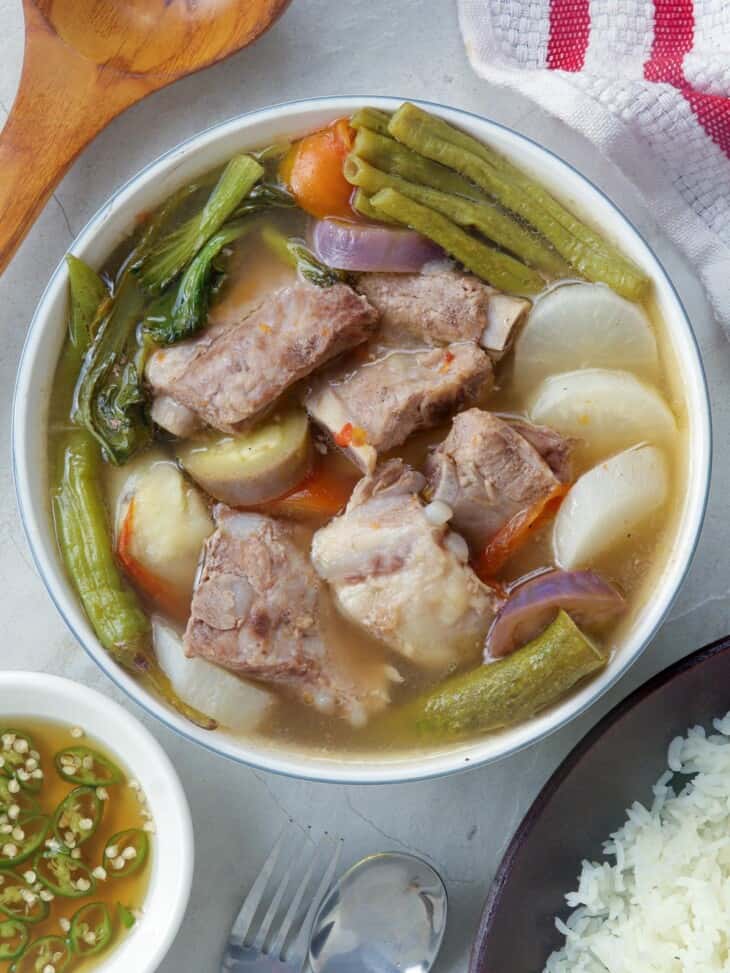Filipino cuisine is a unique blend of indigenous, Malay, Chinese, Spanish, and American influences. It is known for its use of bold, flavorful ingredients, such as garlic, vinegar, and soy sauce, as well as tropical fruits and vegetables.
Adobo: The National Dish of the Philippines
One of the most famous Filipino dishes is adobo, which is made by marinating meat or seafood in a mixture of vinegar, soy sauce, garlic, and other spices, and then cooking it until tender. The result is a tangy, savory dish that is enjoyed throughout the Philippines and beyond. Adobo can be made with chicken, pork, or beef, and each region of the Philippines has its own unique variation of the dish. For example, in the northern region of Ilocos, adobo is often made with vinegar, garlic, and peppercorns, while in the southern region of Mindanao, coconut milk is added to give the dish a richer, creamier flavor.
Sinigang: The Ultimate Comfort Food
Another popular dish is sinigang, a sour soup made with tamarind or other fruits, vegetables, and meat or seafood. The sourness of the soup is balanced by the addition of sweet, juicy ingredients, such as tomatoes, onions, and watermelon. Sinigang is often served with steamed rice, which helps to tame the soup’s acidity and adds a satisfyingly starchy contrast to the tender meat or seafood.

A World of Flavors and Traditions
In addition to adobo and sinigang, there are many other delicious dishes that are worth trying in the Philippines. For breakfast, many Filipinos enjoy a hearty meal of longganisa, or Filipino sausage, fried eggs, and garlic rice. For snacks or dessert, you can try halo-halo, a colorful, creamy concoction of shaved ice, evaporated milk, and various toppings, such as sweet beans, fruit, and jelly.
Filipino food is often served family-style, with a variety of dishes placed on the table for everyone to share. This reflects the importance of community and togetherness in Filipino culture. Eating together allows family members and friends to catch up, bond, and enjoy each other’s company. It also allows everyone to try a little bit of everything, and to discover new flavors and dishes that they might not have tried before.
Fiestas: Celebrating Life with Food
In addition to daily meals, special occasions in the Philippines are often marked by feasts, known as fiestas. These can be religious festivals, such as Christmas and Easter, or celebrations of local traditions and cultural heritage. Fiestas are an opportunity for families and communities to come together to enjoy delicious food and to celebrate their shared traditions.
During a fiesta, a wide variety of dishes may be served, ranging from grilled meats and seafood to sweet, sticky desserts. In some cases, a whole pig may be roasted over an open fire, and guests will line up to enjoy a succulent, crispy slice of lechon, or roast pork. Other dishes that are commonly served at fiestas include pancit, a noodle dish made with vegetables and meat or seafood, and bibingka, a sweet, coconut-flavored rice cake.
Learn more about fiestas in the Philipines – Must See Fiestas and Festivals in Palawan
Foreign Influences and Modern Fusion
In addition to traditional dishes, Filipino cuisine has also been influenced by other cultures over the years. For example, the Chinese have brought their own style of cooking to the Philippines, resulting in dishes like pancit, which is based on Chinese noodles. The Spanish, who colonized the Philippines for more than 300 years, have also left their mark on the country’s cuisine, with dishes like arroz caldo, a comforting rice and chicken soup that is flavored with garlic and ginger.
More recently, Filipino chefs have been experimenting with modern fusion cuisine, combining traditional flavors with international ingredients and techniques. This has led to the creation of exciting new dishes, such as sisig, a sizzling platter of chopped pork, onions, and chili peppers, or kare-kare, a rich stew of beef or oxtail in peanut sauce, served with steamed vegetables and shrimp paste.
Despite these foreign influences, Filipino cuisine remains deeply rooted in the country’s history and culture. Many dishes are still cooked using traditional methods and ingredients, such as wood-fired stoves, bamboo steamers, and indigenous herbs and spices. This gives Filipino food its unique and authentic flavor, and ensures that the country’s culinary heritage is preserved and celebrated for generations to come.
Continue reading about Filipino Food Culture and Traditions.


Leave a reply